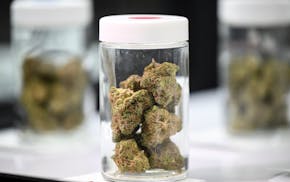Opinion editor's note: Strib Voices publishes a mix of commentary online and in print each day. To contribute, click here.
•••
The passing of cannabis legalization and an amendment cannabis bill in Minnesota in 2023 under a DFL-controlled House, Senate and Governor's Office marked a historic moment for the state. The alignment allowed for significant progress on cannabis reform, including the legalization of recreational cannabis, the establishment of a regulatory framework for cannabis sales, and social equity measures aimed at rectifying harms caused by past criminalization.
However, the landscape following Tuesday's election — with the Minnesota House control currently in a tie (pending recounts) and the Senate remaining narrowly in DFL hands, and with DFL Gov. Tim Walz remaining in the office after his unsuccessful bid for the vice presidency — introduces a complex new dynamic that will shape the future of cannabis policy in the state.
Challenges and opportunities in a divided Legislature
A divided Legislature means that cannabis-related policy changes could face new hurdles. Unlike during the period of unified Democratic control, advancing additional cannabis reforms may require a greater emphasis on bipartisan negotiation and compromise. This shift could slow or stall efforts to refine regulations, expand social equity provisions or address emerging market challenges in Minnesota's cannabis industry. Measures like tax adjustments, licensing expansions or new social equity initiatives could be particularly contentious, requiring careful coalition-building among legislators.
On the other hand, the situation in the Legislature could present opportunities for advocates to bridge divides and highlight the economic, social and public health benefits of cannabis reform. Legislators from both parties may find common ground on issues such as ensuring a robust regulatory structure, enhancing public safety and supporting small businesses within the industry.
Governor's role as a Democratic counterweight
With a DFL governor still in office, the executive branch can continue to play a pivotal role in shaping cannabis policy. The governor may use the position to influence public discourse, veto restrictive legislation or champion initiatives that expand access and address systemic disparities within the cannabis market. This provides a measure of stability and continuity for Minnesota's cannabis industry, even in the face of legislative gridlock.
The path forward
Moving forward, Minnesota's cannabis policy landscape will likely be shaped by pragmatic compromises and incremental progress. Stakeholders, including businesses, community groups and regulators, must remain engaged to ensure that the state's cannabis framework continues to evolve in ways that reflect the needs and values of its residents. While a divided Legislature presents challenges, it also underscores the importance of collaboration in crafting policies that support the long-term success and equity of Minnesota's cannabis industry.
Elsewhere:
On Election Day, voters in Nebraska, North Dakota, South Dakota and Florida considered various cannabis legislation measures, with mixed outcomes.
In Florida, Amendment 3, which proposed legalizing recreational cannabis for adults 21 and over, failed to pass. Although medical cannabis remains legal in the state, the expansion to recreational use was rejected, leaving current laws unchanged.
North Dakota also saw a setback for cannabis legalization as Initiated Measure 5 to legalize recreational cannabis for adults 21 and over did not pass. The measure would have allowed for regulated production, processing and sales of recreational cannabis, as well as protections and regulations for adult users. However, the state will continue to only permit medical cannabis use.
In South Dakota, Initiated Measure 29, which aimed to legalize recreational cannabis for adults 21 and over, similarly failed. The measure included provisions for personal possession, home cultivation of up to six cannabis plants, and restrictions on cannabis use in specific areas, but it did not garner enough voter support.
Nebraska was the exception among these states, as voters approved Initiative Measure 437 to legalize medical cannabis. This new law allows individuals with a written recommendation from a health care provider to possess and use medical cannabis, with a cap of up to 5 ounces. Initiative Measure 438, which legalizes the possession, manufacture and distribution of medical cannabis by registered private entities and establishes the Nebraska Medical Cannabis Commission for regulation, also passed.
With these results, 24 states now allow for adult-use (recreational) cannabis, while 39 states have legalized some form of medical cannabis. The mixed results reflect the complex and varied public attitudes toward cannabis regulation across different regions of the country.
As a cannabis columnist and a cannabis business owner, I can't help but feel a mix of hope and disappointment following the recent election outcomes on cannabis legislation. While Nebraska's decision to embrace medical cannabis is a step toward compassionate care and progress, the rejection of adult-use legalization measures in states like Florida, North Dakota and South Dakota reminds us that the road to broad acceptance remains a complex journey shaped by deeply rooted beliefs and varying regional priorities.

Dabney: Blazing new trails in cannabis research and education
Dabney: This 420 is going to be lit

Dabney: Will tribes have an unfair advantage in Minnesota's cannabis market?
Dabney: Is Minnesota's cannabis market already in trouble?

